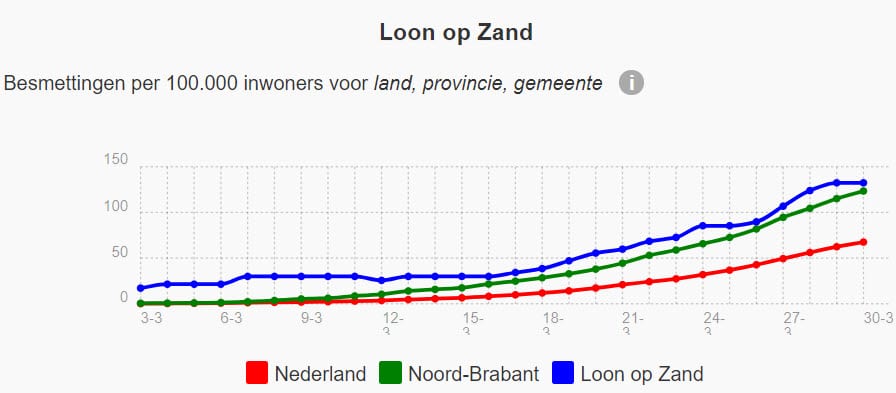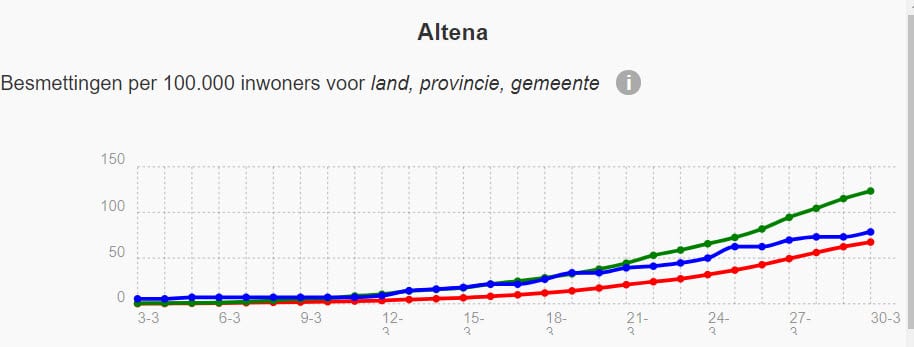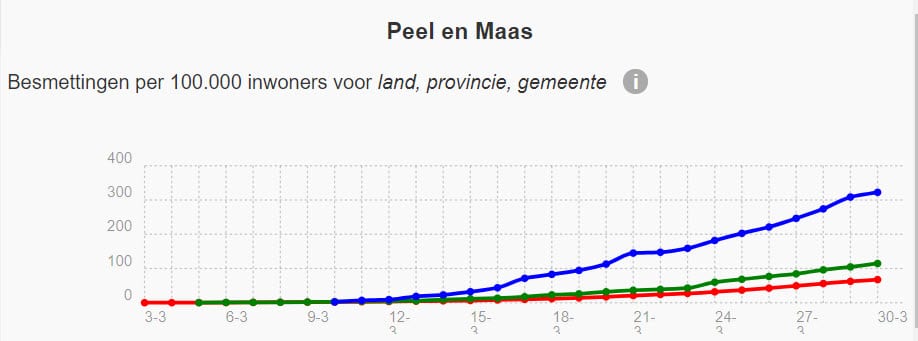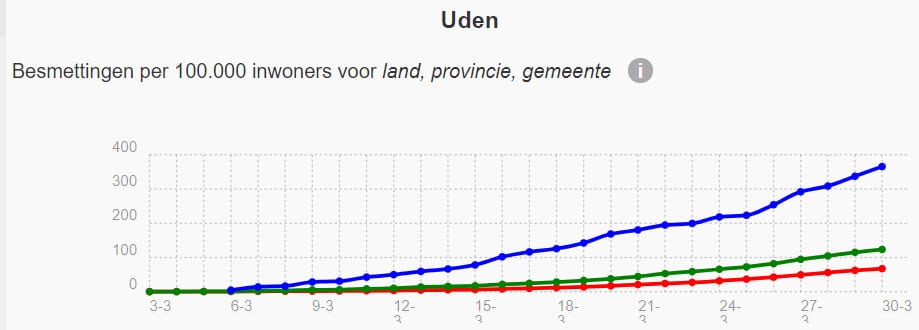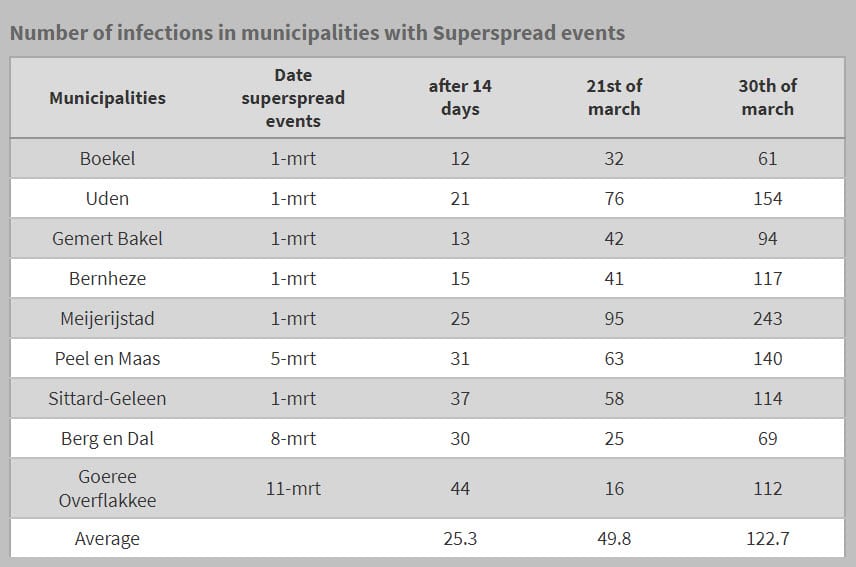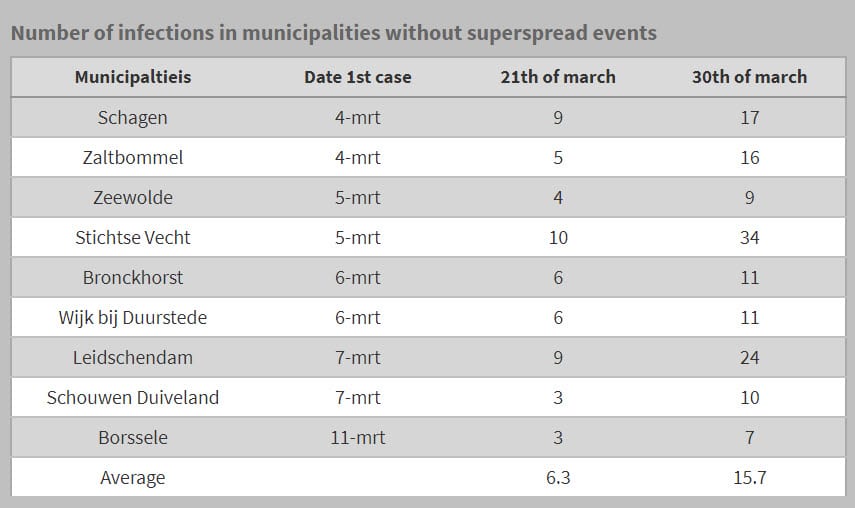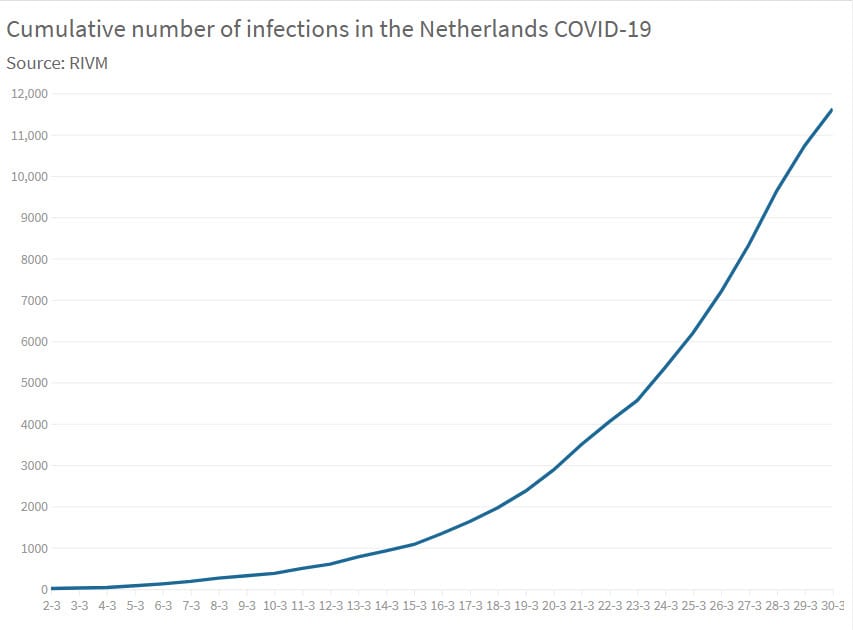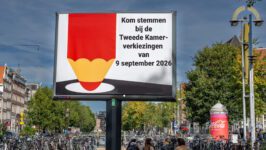The spread of the virus is already virtually under control Summary In this article I show how the COVID-19 virus spread before 15 March, before we took measures in the Netherlands. The overviews per municipality show, that the speed of the virus spreading increased enormously when a so-called “super spread event” was held. Without superspread-events, […]
Lees volledig artikel: The spread of the virus is already virtually under control
The spread of the virus is already virtually under control
Summary
In this article I show how the COVID-19 virus spread before 15 March, before we took measures in the Netherlands. The overviews per municipality show, that the speed of the virus spreading increased enormously when a so-called “super spread event” was held. Without superspread-events, the virus spread quite slowly. And that even though no measures had been taken at that time. I repeat: none!
After the Netherlands decided on measures around mid-March, we saw in many infected municipalities, that the R0 factor (the speed of reproduction) gradually decreased. Partly due to those measures, but partly also due to the fact that no meetings/events were allowed to be organised.
These findings from the first weeks of March indicate, that the chance of another major outbreak if we mitigate measures is very small. As long as we keep (larger) meetings prohibited for the time being. That is why the government can already take quite a few steps to reduce the measures taken without major risks. I discuss this at the end of the article and give some advice on how we can pick up our lives wisely again without ending up in a 1.5 meter society.
The findings
Below I show you that the COVID-19 virus spreads much less without “superspread events”. This should have major consequences for the exit strategy decision making. Especially because it also shows that the chance of a new outbreak -with the right choice of measures- is virtually nil.
It is important to realize that there are two main ways in which the virus jumps from one human being to another:
- A non-infected person comes into close contact with virus droplets, which have escaped from the mouth or nose of a virus carrier. The WHO and RIVM assume that if you stay 1.5 metres away from another person and everyone complies with the instructions on a good personal hygiene, the chance to get infected is very small. In addition, new research shows that the chance that the virus is transmitted via objects is also very small.
- An infected person also excretes micro droplets (aerosols). These can remain floating in the air, so that micro droplets from one infected person, can infect many others. In the past month, more and more information has become available about large-scale and small-scale gatherings, where this has happened to a large extent. I call these events “super spread events”. A Canadian journalist has posted an interesting article documenting 58 of these super spread events.
Bergamo-Valencia soccer
I have already described the effect of the super spread events on the spread of the COVID-19 virus. I described what happened around the Atalanta Bergamo-Valencia’s soccer match on February 19th and what happened after a benefit evening in the Dutch town of Kessel on March 5. But we also know about super spread events in for example Daegu (Korea), Madrid, Mulhouse, Kuala Lumpur and New Orleans (Mardi Gras). And recently I also saw on television that there has been a big New Year’s Eve meeting in Wuhan on 25 January.
The conditions are apparently such that those small particles of the virus can remain in the air for a long time and then infect many of those present. It seems that when attendees sing, the risks are greatest, amplified by poor ventilation and/or low humidity. (Comparable patterns can also be recognized in the case of massive infections of passengers on cruise ships, crew on naval vessels, and in care institutions).
Around 15 March, measures were taken in the Netherlands to slow down the spread of the virus. This means that its effects must be reflected in the figures from 21 March onwards. The previous figures therefore reflect the period in which we were still living together in a normal way. The virus still had free rein then.
Underestimation
Fortunately there are figures available for the development of the number of infections per day per municipality. It is important to realize that the estimation of the number of infected people, all over the world, is a big underestimation of the number of real infections. In the Netherlands, I estimate that in reality the number of people infected is a factor of 50 higher than the test shows. (This is in line with the results of a random survey in LA County). That would mean that by the end of March around 600,000 people in the Netherlands were infected (more than 3%).
Here you will find maps and graphs with figures per municipality. These come from the RIVM and are beautifully processed by the Geodienst in Groningen and the Aletta Jacobs School of Public Health. Based on these figures, I have made the analyses, which you can see below.
So I want to delve deeper into the contamination spread in the Netherlands, before the measures that were taken, had any impact. Because we can learn a lot from when we phase out measures. The number of infections was monitored by the RIVM per municipality until 30 March, so the last 9 days of that month reflect the period that the measures should already have had an impact on the spread of the virus.
R0
R0 is the important factor in a pandemic. The so-called reproduction factor indicates how quickly the virus spreads. The value 2 means that 1 carrier of the virus infects an average of 2 people in 6 days. After 18 days a total of about 18 people would be infected and after 30 days 78. The aim is to bring this R0 below 1. In that case there will be fewer and fewer new infections.
In the case of influenza, an R0 value of between 1.1 and 1.3 is maintained. On COVID-19 the consensus seems to be that the R0 without any measures is somewhere between 2.2 and 2.5. If it were 2.5 then 1 infected person would have infected up to 260 people after 30 days. The RIVM indicates that in the Netherlands, somewhere at the end of March, the R0 had come close to 1 and then went further down.
And the big question is of course what exactly the risks are if measures are reduced. The mantra seems to be, that it could go wrong again if we take the wrong step or phase out too quickly. But how big are the risks? That seems to be pure speculation at the moment.
However, there is a way to look more rationally at how big the risks really are. Because before March 15th we just lived a normal life, so the virus could spread optimally. It is only with the observations from 21 March onwards that the measures must have had an effect.
Important clues
If you then look at the figures from individual municipalities, there are important clues as to what could happen if we were to phase out measures.
Let’s focus on the municipality of Loon op Zand. At the end of February, the first Corona patient in the Netherlands was recorded there. These are the cases per day by 100,000 inhabitants.
(These graphs are the figures per 100,000 inhabitants. For our purpose we are especially interested in the increase factor of the development in time.
At the beginning of March there were 4 virus carriers in Loon op Zand, all in one family. On 21 March there were 14. But even if, as a calculation example, we pretend that at the beginning of March not 4, but only 1 person was infected, that would be more indicative of an R0 somewhere around 1.2. In the last 9 days of the month, the number of infected persons only increased by a factor of 2. And that also indicates an R0 close to 1.0. (You should always take into account that an infected case detected represents on average 50 infected persons because of underestimation).
Also in the municipality of Altena near the Biesbosch there was already one infected person at the beginning of March.
After 21 days the number of infected persons in Altena stood at 22. This indicates an R0 of 1.2. In the last 9 days the number of infected persons doubled as well. And this also indicates an R0 value close to 1.0.
But how is it that in March the number of infected people in the Netherlands increased exponentially?
I show this by zooming in on a number of municipalities where a super spread event took place. Peel and Maas is a good example. In the village of Kessel (more than 4,000 inhabitants) there was a benefit meeting with more than 300 people on March 5th.
The event was on March 5. On March 11 the first infections in the municipality were registered and on March 21 there were already 63. So in 10 days the number of infected people has increased significantly. Based on the underestimation of the number of people actually infected, that would mean that on March 21, 16 days after the event, more than 3,000 people in that municipality (with a centre of gravity in Kessel) had already been infected. This is an R0 that is significantly above 5.0. However, between 21 and 30 March, the number of infected persons in this municipality increased by just over a factor of 2. And that resembles the figures of Loon op Zand and Altena. So the effect of the measures taken around March 15th!
While in Peel en Maas the super spread event of March 5th was the starting point of the big outbreak, in Uden it was Sunday March 1st. We can see that in the graph below. Almost certainly someone was present at one or more church services who was infected at that time and sang along.
The first infection was detected on March 6th. On March 21 the number of infected persons in Uden was 76. An increase in 15 days by a factor of 76. That too is an R0 that is far above 5. And also in Uden we see that between 21 March and 30 March the increase was only a factor 2. So an R0 that came close to 1.0.
R0 over 1.0
Emmen is a municipality, which has an even slower spread than Altena. On March 8 the first infection was detected and only 4 on March 21. So without any measures in Emmen with 100,000 inhabitants there was only an R0 of just over 1.0 !!!
Here we see in the last 9 days a somewhat larger increase than in the other municipalities. It increases by a factor of 3.5. At the end of the month Emmen (via that multiplication factor of 50) had an estimated 0.7% infected persons in the municipality, whereas in Uden it must have been 15% already.
Also when we look at other municipalities it is striking that in quite a few municipalities we recognize the influence of super spread event. Church services on March 1 and 8 and the “afternoons for the crop”celebrations on 11 March seem to qualify as super spread events in those congregations. But I have also been notified of outbreaks of the virus after choir rehearsals or – performances.
Below is a selection of these municipalities:
For comparison a number of municipalities that already had an infection in the first 10 days of March, but where the spread was much slower, apparently because no super spread event had taken place.
If you look at the development in larger municipalities, with 5 to 20 times more inhabitants than those small ones, then by the law of the large numbers it becomes a mix of superspread events and the “normal” spread from person to person. And you can’t recognize them separately anymore.
In Tilburg (not far from Loon op Zand) the first infection was on March 1st. On March 21 the number was 154. That indicates an R0 of over 4. It is very likely that also in Tilburg between March 1 and 8, through church services, choir rehearsals or parties, super spread events took place.
Between March 21 and 30 we also see an increase of only a little more than the factor 2 in Tilburg. Breda shows, with a delay of a few days, the same pattern as Tilburg.
Exponential growth
If you only look at the total figures in the Netherlands per day, you can see an exponential growth until the end of March. But if you look at the municipalities separately, you see a much more nuanced picture. While in most municipalities where the virus had been circulating for some time, the increase between 21 March and 30 March was only around a factor of 2, for the whole of the Netherlands it was a factor of 2.8. And that’s because on mid-March there were still 120 municipalities where no infection had yet been detected and most of them only got going in the last part of March.
Conclusions
The study of the development in the municipalities between March 1 and 21, shows that super spread events, when no measures were in place, led to a very sharp increase in the number of infections. Without these events and without any measures such as social distancing and banning visits to the hospitality industry, hairdressers, manicures, etc., the R0 seems to be somewhere between 1.1 and 1.5. A value that resembles that of influenza.
In this blog I have explained why in case of flu epidemics, we cannot easily recognize the influence of super spread events. But with COVID-19, with no historical immunity among the attendees, you immediately notice a week after the event that it had a major impact.
If we were to live our lives again, exactly as we did before 15 March (something I absolutely do not advocate) and we would only forbid meetings of more than 3 people, then the R0 alone would drop to a value of around 1.2 to 1.3. For the record, that’s just by living our normal lives as we did before March 10 and certainly not as a “1.5 meter society”!
Similar pattern
The Israeli chairman of the “National Council for Research and Development”, a mathematics professor, noted that a similar pattern can be recognized all over the world. The first 40 days an increase and then a decrease. Which he indicated seemed to come to zero after a while.
In discussions he indicated that he had no explanation for this, but found it remarkable, that it seemed that the measures governments had taken, or not taken, had little influence on that curve. Wherever he looked, he saw more or less the same pattern, also in a country like Sweden.
My analysis is the missing link in this professor’s finding. Because there is one measure that has been taken almost everywhere in the world:
Prohibiting meetings with a larger number of people.
Virtually all countries have, in addition to the measures they have taken (from a complete Lock down, via an intelligent Lock down, to a somewhat freer approach like in Sweden), decided that ‘super spread events’ can no longer take place. This alone has considerably slowed down the spread of the virus. The other measures taken by governments, push the R0 (well) below 1 and that is the image that the Israeli professor saw all over the world.
This should have major consequences for the exit strategy of governments worldwide and certainly to the Dutch!
As long as the meetings with a larger number of people remain forbidden, there is no chance that there will be another major outbreak of the virus “which will undo all our efforts” as Premier Rutte said, at the intercession of the Outbreak Management Team members.
We could already take steps now, which will keep the chance of new infections smaller than in many low infected municipalities before March 21 this year.
Of course with a smart policy. Just like Germany mandatory mouth protection in public transport and shops would already be a good step away from the completely unnecessary 1.5 meter society, as I have shown above. Making hairdressers, manicures, pedicures, beauticians (with mouth guards) work again can be done without any objections. Also the hospitality industry could start up again. Especially venues with outdoor terraces. But also others, with some extra facilities inside.
Mouth protection
I also think that it will be proven, that wearing mouth protection anywhere outside also means that we don’t have to keep a 1.5 meter distance. East Asia shows us the way. And in Jena in Germany they have been doing that for some time with very good results. But if we don’t want to / can’t do that yet, then the 1.5 meter distance (except in public transport and shops) is still a good choice. And older people are indeed the most vulnerable and they should be more cautious for the time being. (Here, too, mouth protection for the elderly themselves and their visitors is a wise choice).
A number of other important lessons have been learned from those super spread events. Which we still have to apply as long as the COVID -19 virus is still present.
It is evident that in confined spaces where foreign people gather, the risk of the virus spreading via aerosols is greatest. Good ventilation and an air humidity of 45% at 20 degrees Celsius is an extra precaution against this spread via aerosols.
Internal ventilation
In offices, care institutions and schools, the way in which internal ventilation and heating/cooling is regulated is a risk factor. Here too, there are clear indications that aerosols spread via these types of systems if they are not properly regulated. How do you think that 900 people got infected on a naval vessel? Not because all those 900 people have moved within one and a half metres of an infected person.
No, it’s mainly because of those floating aerosols. The same risk was/is also present in care institutions. Usually little fresh air ventilation. Where many people are infected in a care facility, two causes are most obvious: church service and festive evening with many residents of the facility, or the internal heating/ventilation system.
Although it is undoubtedly true that children are less vulnerable to the spread of COVID-19, a day at school could also turn into a super spread event. To avoid this, schools should do the following:
- Ventilate as much as possible and teach in the open air if possible.
- Bring the air humidity in the building to the level of 6 g/kg (that’s about 45% relative humidity at 20 degrees Celsius). Here you can calculate this value.
- If the ventilation and/or air circulation or humidity inside the school is not good, use mouth protection.
- And certainly stop singing in classes.
Good balance
On that basis it is very well possible to keep a good balance between public health and the importance of the economy and society.
We have to get rid of the unfounded fear that the virus could re-erupt at any moment, when we know that we have banned the biggest source of the spread, the super spread events. Let’s use the energy together to start up society again quickly and smartly on the basis of good analyses and data and not on the basis of empty cries.
Last but not least, there are many indications that as it gets warmer and more humid, the spread of the virus will be further slowed down, including in this research by Homeland Security’s lab in the US. Not that the virus will disappear completely. In the autumn these conditions will become more unfavorable again. But then we have already learned a lot more (at least that should be the case), in order to prevent a large spread of the virus, as it has happened for the last month and a half.
You have just read: The spread of the virus is already virtually under control.




